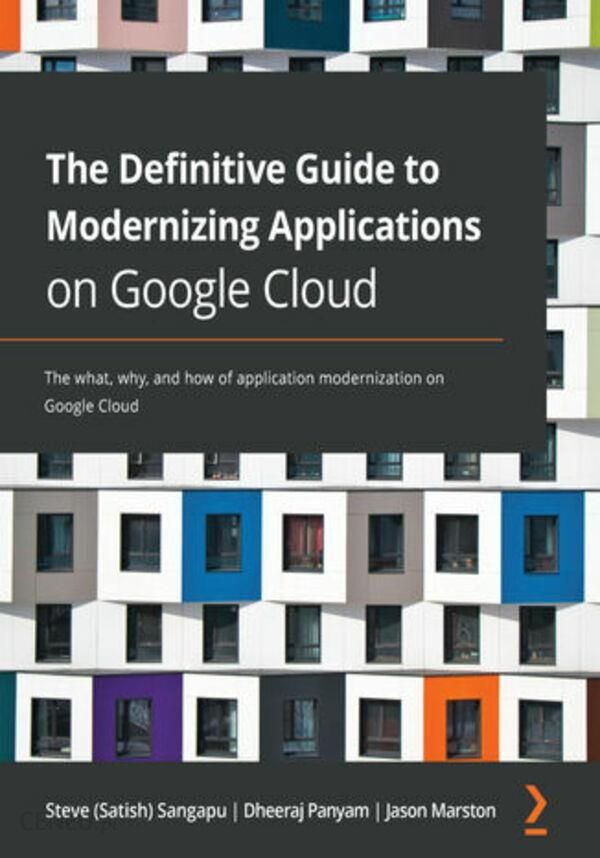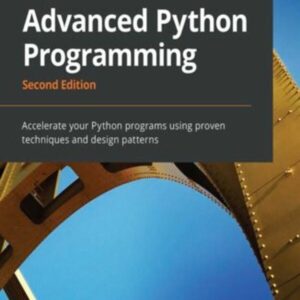Description
Legacy applications, which comprise 75-80% of all enterprise applications, often end up being stuck in data centers. Modernizing these applications to make them cloud-native enables them to scale in a cloud environment without taking months or years to start seeing the benefits. This book will help software developers and solutions architects to modernize their applications on Google Cloud and transform them into cloud-native applications.This book helps you to build on your existing knowledge of enterprise application development and takes you on a journey through the six Rs: rehosting, replatforming, rearchitecting, repurchasing, retiring, and retaining. Youll learn how to modernize a legacy enterprise application on Google Cloud and build on existing assets and skills effectively. Taking an iterative and incremental approach to modernization, the book introduces the main services in Google Cloud in an easy-to-understand way that can be applied immediately to an application.By the end of this Google Cloud book, youll have learned how to modernize a legacy enterprise application by exploring various interim architectures and tooling to develop a cloud-native microservices-based application. Spis treści:The Definitive Guide to Modernizing Applications on Google CloudContributorsAbout the authorsAbout the reviewerPrefaceWho this book is forWhat this book coversTo get the most out of this bookDownload the example code filesDownload the color imagesConventions usedGet in touchReviewsShare Your ThoughtsSection 1: Cloud-Native Application Development and App Modernization in Google CloudChapter 1: Cloud-Native Application FundamentalsThe cloud-native ecosystemBenefits of cloud-native applicationsIncreased speed of deliveryIncreased scalabilityIncreased resiliencyMixed technology stack and workforceContinuous integration and deliveryIncreased automationPrinciples of cloud-native architecturePrinciple 1 lightweight microservicesPrinciple 2 leveraging automationPrinciple 3 DevOps culturePrinciple 4 better to go managedPrinciple 5 innovateLimitations of microservicesApplying the 12-factor app principles on Google CloudCode baseDependenciesConfigBacking servicesBuild, release, runProcessesPort bindingConcurrencyDisposabilityDev/prod parityLogsAdmin processesSummaryChapter 2: End-to-End Extensible Tooling for Cloud-Native Application DevelopmentMoving past third-party services the beauty of end-to-end toolingGoogle Cloud CodeFeatures and benefits of Cloud CodeThe role of Cloud Code in the cloud-native app development pipelineGoogle Cloud BuildFeatures and benefits of Cloud BuildThe role of Cloud Build in the cloud-native app development pipelineGoogle Container RegistryFeatures and benefits of GCRThe next-gen container registry Artifact RegistryThe role of GCR in the cloud-native app development pipelineGoogle Cloud RunFeatures and benefits of Cloud RunThe role of Google Cloud Run in the cloud-native app development pipelineGoogle Kubernetes EngineFeatures and benefits of GKEThe role of GKE in the cloud-native app development pipelineOperations suiteFeatures of Google Cloud MonitoringFeatures of Google Cloud LoggingThe role of the Cloud operations suite in the cloud-native app development pipelineSummaryChapter 3: Cloud-Native Architecture Patterns and System Architecture TenetsCloud-native patternsThe scope of cloud-native patternsSolving challenges with cloud-native patternsBe proactive, not reactiveScaling and performanceDeploymentsResiliency and availabilityMonitoringSecurityCloud-native design patternsMicroservicesStrangler applicationsDecomposition patternsEvent-driven patternsCommand Query Responsibility SegregationThe saga patternMultiple service instancesCanary deploymentsStateless servicesImmutable infrastructureAnti-corruption layerAPI compositionEvent sourcingThe Retry patternCircuit breaker patternThe bulkhead patternUsing the cloud-native pattern judiciouslyHybrid and multi-cloud architecture recommendationsDistributed deployment patternsRedundant deployment patternsSummarySection 2: Selecting the Right Google Cloud ServicesChapter 4: Choosing the Right Compute OptionFive compute options and FirebaseFirebaseCloud FunctionsGAECloud RunGKEGCEPricingHow important is it to choose the right option?Changing compute optionsMaking a decisionSummaryChapter 5: Choosing the Right Database and StorageStorage and database options on Google Cloud the big threeGCS basicsGCSCloud SQLCloud Firestore (previously Datastore)Cloud SpannerCloud BigtableWrapping up the big fiveAdditional storage and database optionsBigQueryFilestorePersistent disks/local solid-state drive (SSD) (block storage)MemoryStoreSecurity and flexibilitySummaryChapter 6: Implementing a Messaging and Scheduling SystemUnderstanding the requirements of a messaging systemRequirement #1: ScalabilityRequirement #2: ExtensibilityRequirement #3: AgilityRequirement #4: ResiliencyIntroduction to asynchronous messagingMessaging products available (open source and cloud native) on the marketAmazon SQSKafkaRabbitMQNATS StreamingAdvantages of asynchronous messagingIntroduction to Pub/SubWhat is Cloud Pub/Sub?Pub/Sub key featuresAdditional benefitsPub/Sub Concepts topics and subscriptionsPub/Sub model fan-in and fan-outPull versus push types differences and when to use each typeGetting started with Cloud Pub/SubIntroduction to Cloud TasksIntroduction to Cloud SchedulerSummaryChapter 7: Implementing Cloud-Native SecurityThe principles and concepts of cloud securityEconomy of MechanismDefense in DepthPrinciple of Least PrivilegeAdding infrastructure security layers (revision)Cloud IAMTraditional access control versus Cloud IAMConcepts of IAMEntityIdentityPermissionsPolicyAuthentication and authorizationCloud IAM on Google Cloud PlatformFeatures of Cloud IAMComponents of Cloud IAMMembersAll authenticated usersAll usersResourcesPermissionsRolesIAM policy bindingsLimitations of Cloud IAMCloud IdentityFeatures of Cloud IdentitySetting up Cloud IdentityCloud Identity PlatformFeatures of Cloud Identity PlatformBeyondCorp (a new approach to enterprise security)Cloud Identity-Aware Proxy (IAP)SummarySection 3: Rehosting and Replatforming the ApplicationChapter 8: Introducing the Legacy ApplicationTechnical requirementsThe infrastructure architectureThe software architectureSpring BootThymeleafBootstrapjQueryExplaining the software architectureImplementing the softwareSpring Boot configurationUnderstanding the layers of the applicationThe presentation layerThe controller layerThe domain layerValidation and defensive programmingSummaryChapter 9: The Initial Architecture on Google Compute EngineTechnical requirementsThe initial infrastructure designDesigning our networkDesigning our network securityCreating the modernization projectImplementing the networkImplementing the VMsImporting the dataSummaryChapter 10: Addressing Scalability and AvailabilityTechnical RequirementsDesigning for scalability and availabilityUsing instance templatesUsing managed instance groupsUsing an HTTP(S) load balancerSummaryChapter 11: Re-Platforming the Data LayerDesigning for scalability and availabilityUsing Cloud MemorystoreProvisioning a Cloud Memorystore instanceUpdating the Regional Managed Instance GroupUsing Cloud SQLUsing Cloud SQL ProxyUsing Cloud SpannerProvisioning Cloud SpannerUpdating the buildUpdating the application settingsImporting data into Cloud SQLExporting data from our MySQL virtual machineImporting to Cloud SQLCloud SQL versus Cloud SpannerSummaryChapter 12: Designing the Interim ArchitectureThe infrastructure architectureGoogle Identity PlatformCloud Pub/SubThe software architectureRefactoring the frontend and exposing REST servicesAdding Google Identity Platform for identity and authenticationPublishing eventsConsuming eventsRefactoring to microservicesMicroservice boundariesSummaryChapter 13: Refactoring to MicroservicesTechnical requirementsAnalyzing the structure of the application backendRefactoring into microservicesRefactoring the databaseThe web frontendThe Strangler Pattern revisitedGoogle HTTP(S) Load Balancer RoutingGoogle App Engine DispatcherApigee API ManagerContainerizing the deployment units with DockerSummarySection 4: Refactoring the Application on Cloud-Native/PaaS and Serverless in Google CloudChapter 14: Refactoring the Frontend and Exposing REST ServicesTechnical requirementsCreating REST controllersCreating an AngularJS web frontendModulesComponentsRoutingServicesAuthenticating in the web frontendSetting up Firebase and Google Identity PlatformInitializing Firebase AuthenticationRouter updatesThe authentication cycleThe signout controllerValidating the authentication token in the REST controllersThe authentication filterSummaryChapter 15: Handling Eventual Consistency with the Compensation PatternTechnical requirementsThe distributed transaction problemThe compensation patternCreating topics and subscriptions with Google Cloud Pub/SubImplementing eventual consistency and the compensation patternDeploying and testing the applicationSummaryChapter 16: Orchestrating Your Application with Google Kubernetes EngineTechnical requirementsIntroducing GKEModes of operationCreating a GKE clusterConfiguring the environmentKubernetes ConfigMaps and SecretsDeploying and configuring the microservicesKubernetes PodsKubernetes ReplicaSetsKubernetes DeploymentsKubernetes Horizontal Pod AutoscalersKubernetes ServicesAutomating the deployment of our componentsConfiguring public access to the applicationKubernetes-managed certificatesKubernetes IngressWhen to use GKESummaryChapter 17: Going Serverless with Google App EngineTechnical requirementsIntroducing Google App EngineGoogle App Engine standard environmentGoogle App Engine flexible environmentComponents of App Engine and the hierarchy of an application deployed on App EngineDeploying containers to the App Engine flexible environmentApplication configuration updatesDeployment configurationAutomating deploymentWhen to use Google App EngineSummaryChapter 18: Future Proofing Your App with Google Cloud RunTechnical requirementsCloud RunThe Knative stackCloud Run environmentsDeploying containers to Google Cloud RunFrontend configurationService manifestGoogle Cloud BuildDomain name mappingWhen to use Cloud RunSummaryAppendix A: Choosing the Right Migration StrategyStep 1 assessCataloging existing applicationsEducating teamsChoosing what to migrate firstCapable and innovative teamsThe effort required for migrationLicense restrictions and complianceCan afford downtimeStep 2 planMigration paths versus migration strategiesChoosing the right migration pathStep 3 migrateTransferring your dataDeploying workloadsSetting up automated and containerized deploymentsStep 4 optimizeLetting internal teams takeoverSetting up monitoringLeveraging managed services and automationCost and performanceAppendix B: Application Modernization SolutionsModernizing Java appsWhat is Google Anthos?Preparing to modernize Java appsPhase 1 containerizing Java applicationsPhase 2 Refactoring and re-platformingModernization strategies (the 6 Rs of modernization)Retire, retain, and re-architectWhy subscribe?Other Books You May EnjoyPackt is searching for authors like youShare Your Thoughts
often jaki czas, matura z matematyki 2022, zdawalność matur 2019, ładne angielskie słowa, kurde no, ty jesteś ruda napewno ruda, ile słów na minutę, early stage podręczniki, halo po niemiecku, końcówka po angielsku, wypowiedzi, akcent synonim, dziekuje za uwage po ang, limanowa inn
yyyyy




